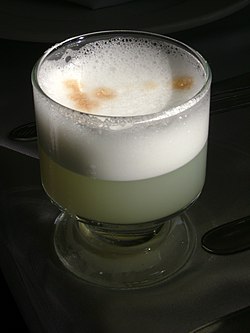Pisco sour: Difference between revisions
Escape Orbit (talk | contribs) m Reverted edits by 24.0.209.37 to last version by Blanchardb (using Huggle) |
No edit summary |
||
| Line 33: | Line 33: | ||
There are at least two common variations concerning the creation of this drink: |
There are at least two common variations concerning the creation of this drink: |
||
=== Chile === |
|||
In Chile, the birth of the Pisco Sour is attributed to the [[England|English]] steward of a sailing ship named "Sunshine". In [[1872]], Elliot Stubb obtained leave to disembark in the port of [[Iquique]], a [[Peru]]vian city in those days, with the aim of settling in the city and opening a bar. In the bar which he established, he experimented with many aperitifs and drinks, of which a fundamental ingredient was the ''limon de pica'', a small [[Lime (fruit)|lime]] grown in the area. |
|||
In order to offer new varieties of alcoholic beverages, the Englishman experimented with many combinations, trying to create pleasant drinks. One day, Stubb mixed pisco with his most valued ingredient, lime, and added a good dose of sugar. Fascinated by the delicious result, he made it the specialty of the house, and dubbed it "sour" for the acid touch which the lime gives it.<ref name="">TurismoChile.com. [http://www.turismochile.com/guide/chile/articles/600 "Pisco in Chile"]. Retrieved [[2006-12-22]].</ref> |
|||
The Pisco Sour spread to social clubs and bars throughout the port of Iquique, and from there it spread through the country and beyond. Dictator [[Augusto Pinochet]]'s favorite cocktail was a pisco sour.<ref><i>Washington Post</i>, Thursday 8 May 2008 page C1 [http://www.washingtonpost.com/wp-dyn/content/article/2008/05/07/AR2008050703965_4.html].</ref> |
|||
Different variations from the original ingredients contained in pisco sour have been produced within Chile. In [[Santiago, Chile|Santiago]] can be found iconoclastic pisco sour recipes that include Ají Sour (with a spicy green chilli), Sour de Campo (with ginger and honey), and Sour Haas (with avocados, pineapple, and mint).<ref>http://www.lonelyplanet.com/travelstories/article/piscosour_1007</ref> |
|||
=== Peru === |
=== Peru === |
||
Revision as of 17:31, 13 June 2008
| Cocktail | |
|---|---|
 Pisco Sour | |
| Type | Cocktail |
| Base spirit | |
| Served | Straight up: chilled, without ice |
| Standard drinkware | Old fashioned glass |
| Commonly used ingredients |
|
| Preparation | Shake hard or blend with ice and strain into glass. The bitters are an aromatic garnish topping the finished drink, put on top of pisco sour foam. |
| Recipe adapted from The Joy of Mixology by Gary Regan | |
A Pisco Sour is a cocktail where national origin is debated if from Chile or Peru.[1] The drink contains Pisco (a regional brandy), lemon juice, egg whites, simple syrup, and regional bitters (like Amargo bitters, though Angostura bitters work if regional bitters are unavailable).[2] In Peru, the variety of lemon used has a flavor similar to key lime. Because of this, some recipes call for the use of lime juice rather than lemon juice. In the United States, the drink is usually made with commonly available Lisbon or Eureka lemons.
Culture
With the increased availability of Pisco and regional bitters outside South America, the Pisco Sour, like the Mojito and Caipirinha, has increased in popularity in the United States. Peru has a National Pisco Sour Day which is celebrated on every first Saturday of February. Chile's Pisco National Day is celebrated on May 15th.[3][4]
Historical debates
The roots of Pisco itself reach back to the 1500s and stem from Colonial rule. The Spaniards brought the grape to the region from Europe, but the King of Spain banned wine in the 17th Century, forcing Peruvians to concoct a different kind of alcohol from the grape.[5]
There are at least two common variations concerning the creation of this drink:
Peru
In the early 1920s, the Pisco Sour cocktail was produced at "Bar Morris" located at Calle Boza 847, Jiron de la Union, Lima.[citation needed] It was enjoyed by a few at first, but the cocktail soon became the favorite of locals and international guests of the Hotel Bolivar and Maury (upscale hotels of that time), which helped the drink gain its current international recognition.
From "Mundial" magazine - Nº 52 - by Jose Julian Perez, April 22, 1921 (translated from the Spanish):
"Speaking about the kitsch and the creole"
"Caressing a glass, which white-ish contents was managed to concoct one of the best disciples of Mr. Morris, the popular owner of the bar located in Boza street, you could find Perez taking good care of a group of his friends, at the climax of the cocktail hour of any given day."
"Perez, after drinking several Pisco Sours, one after another, finally claims victorious: - The kitsch! The creole! This is the healthy joy and the real fun, Let's prove it"
See also
- Drink topics
- Regional topics
References
- ^ http://www.latimes.com/features/food/la-fo-cocktail21-2008may21,0,4918724.story
- ^ Goode, JJ. Cocktail of the month. Epicurious. Retrieved 2006-12-22.
- ^ Template:Es icon http://www.chile.com/tpl/articulo/detalle/ver.tpl?cod_articulo=99895
- ^ Template:Es icon http://noticias.aol.com/articulos/_a/chile-instauran-el-dia-nacional-del/n20080515171009990029
- ^ Daulerio, A.J. & Eric Gillin (2004-02-19). Throw Yourself a Pisco Party. The Black Table. Retrieved 2006-12-22.
External links
- Go2Peru.com - Tourism site with information about Peruvian Pisco along with a recipe.
- Food Network - A less traditional recipe that uses ingredients more common outside Peru and Chile.
